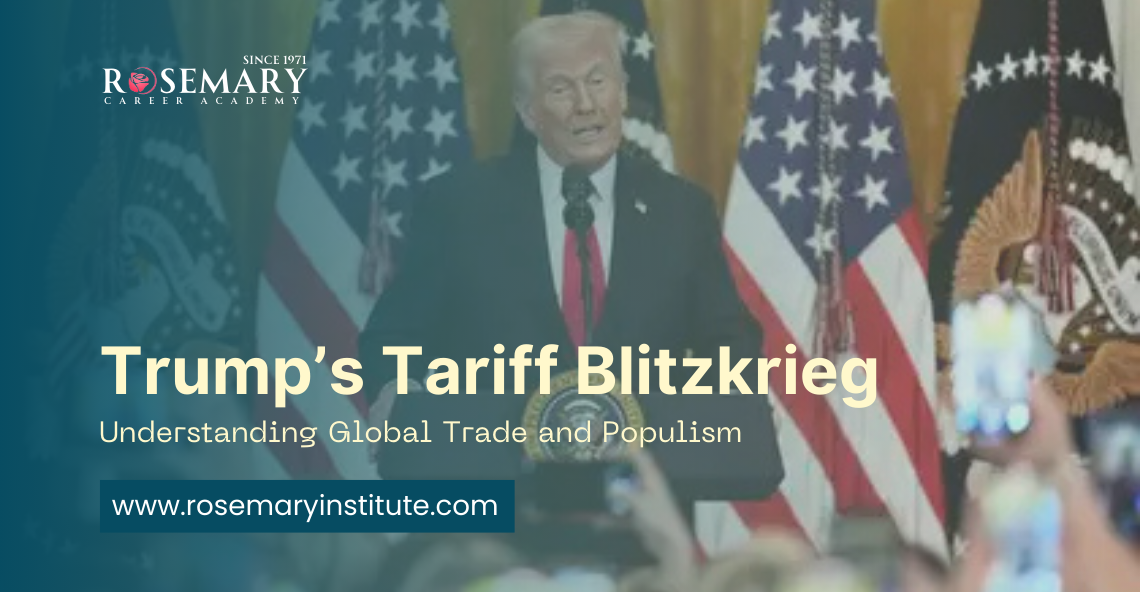Trump’s Tariff War and Globalization Explained for Students | Rosemary Institute
Introduction: Trade Wars in the Modern Era
Global trade has shaped economies, created jobs, and made goods cheaper for decades. However, during Donald Trump’s presidency (2017–2021), the world saw a major shift. Trump’s heavy use of tariffs – taxes on imported goods – sparked debates about the future of globalization and raised important questions about how democracy reacts to economic changes.
In this blog, let’s dive deep into what tariffs mean, why Trump used them, and what this tells us about today’s world.

What Are Tariffs and Why Did Trump Use Them?
Tariffs are taxes that countries place on goods coming from abroad. The idea is to make foreign products more expensive so that people buy local products instead.
For Trump, tariffs were more than just economic tools; they were political symbols. He presented tariffs as a way to “protect American jobs” and fight the effects of globalization. They became a key part of his “America First” policy, appealing to workers who felt left behind by free trade.
However, while popular with some voters, Trump’s tariff policies challenged global trade rules and introduced uncertainty into the world economy.
The Rise and Fall of Global Trade
From the late 1970s to 2008, global trade boomed. Countries exchanged goods freely, and trade became a larger part of the world economy. The U.S. played a huge role, opening its markets to goods from around the globe.
But after the 2008 financial crisis, the growth of trade slowed down. Global trade as a share of global GDP stopped rising, and in some places, even declined. Experts call this the “slowbalization” phase — globalization didn’t stop, but it wasn’t growing like before.
This slowdown set the stage for political leaders like Trump to argue that globalization needed to be controlled or reversed.
Tariffs: More Than Just Taxes
Economically, tariffs are highly debated. Some say they are necessary to protect strategic industries. Others argue they are harmful, raising prices for consumers and sparking trade wars.
Trump’s tariffs:
- Targeted China, the European Union, Canada, and Mexico.
- Affected industries like steel, aluminum, and agriculture.
- Brought retaliatory tariffs from other countries, hurting American farmers and manufacturers.
Thus, tariffs became a double-edged sword: they showed strong leadership to supporters but disrupted global supply chains.
Dual Attack on Globalisation: Goods and People
Trump’s policy wasn’t just about goods—it was about people too.
- Trade Barriers: High tariffs discouraged foreign goods, encouraging domestic production.
- Immigration Controls: Tighter immigration rules reduced the movement of labor into the U.S.
This two-pronged approach tried to bring capital (money and factories) back to the U.S. while limiting the flow of workers from other countries. In short, Trump wanted goods and jobs to stay inside America.
The Economic Theories Behind It
Global trade is usually supported by the theory of comparative advantage — the idea that countries should specialize in what they do best and trade for the rest. In the early stages, globalization:
- Lowered prices.
- Increased choices for consumers.
- Helped poorer countries grow.
But over time, it also caused:
- Factory closures in the U.S.
- Job losses in industries like textiles and manufacturing.
- Growing inequality between rich and poor regions.
People in areas that lost industries started questioning if globalization was really benefiting everyone.
Populism and the Political Reaction
The economic pain of globalization contributed to the rise of populism — a political movement that claims to represent “ordinary people” against elites and outsiders.
Populist leaders, including Trump, tapped into the frustration by blaming:
- Foreign countries for “stealing jobs.”
- Immigrants for “lowering wages.”
- Global elites for “ignoring common people.”
Tariffs were used as proof that populist leaders were taking action to protect their citizens.
Economic Discontent: A Deepening Divide
One of globalization’s biggest failures has been the uneven distribution of benefits:
- Wealthy areas thrived with new industries like technology and finance.
- Lower-skilled workers, especially in the U.S. Midwest and South, lost secure factory jobs.
This growing gap in wealth and opportunity created fertile ground for political anger and radical changes like Trump’s tariffs.
Democracy and Global Trade: A Complex Relationship
Interestingly, democracy both enabled and limited Trump’s policies:
- Enabled: Democratic elections allowed Trump to rise to power based on anti-globalization promises.
- Limited: Democracy also allows voters to push back if the tariffs cause more harm than good (such as higher prices, lost export markets, or slower economic growth).
Thus, democracy acts as a corrective force — it can legitimize new ideas, but it also forces leaders to adapt if their ideas fail.
Global Trends: A Divided World
Today, the global trade landscape looks very different:
- The U.S. and Europe are becoming more cautious about globalization.
- China and India are still engaging deeply with global markets, pushing for more trade and investment.
There is now a growing political and economic divergence — not everyone sees free trade as a win-win anymore.
Conclusion: Lessons for the Future
Trump’s tariff blitzkrieg wasn’t just about economics; it was about how societies react when large groups feel left out. Tariffs and populism represent a backlash against globalization’s failures.
But remember — democracy remains flexible. It allows citizens to voice frustrations but also to correct course if policies don’t deliver real improvements.
For students, understanding these dynamics is crucial. The world isn’t just shaped by money and markets — it’s shaped by people’s hopes, fears, and votes.






If this leads to more purchase of Made in India products then it’s better for our country. Now people should restrict themselves from buying foreign luxury goods as it will be more costlier and boost other countries economy.